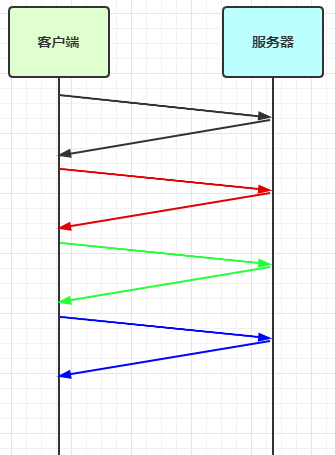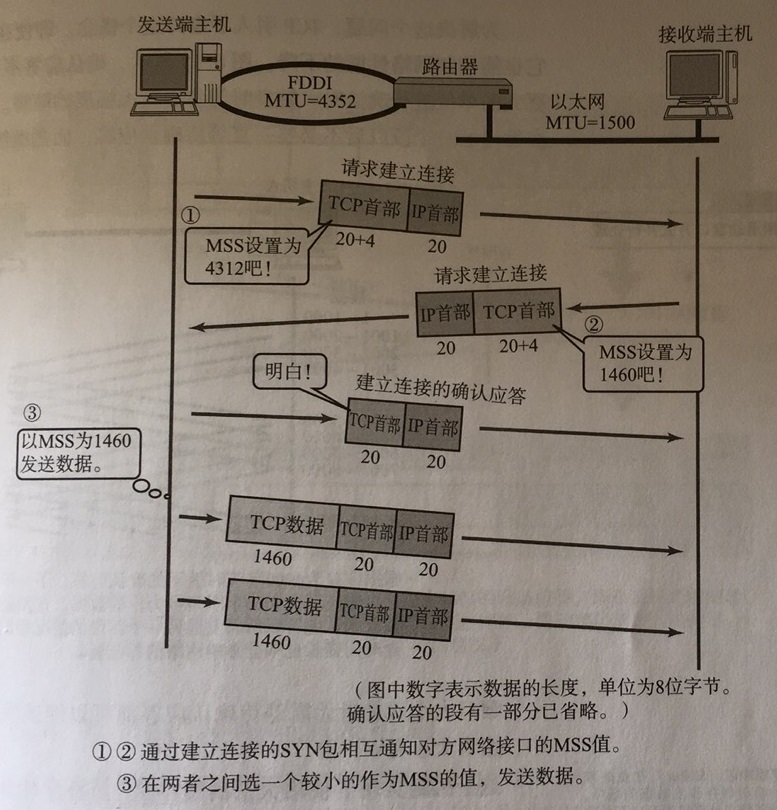01.Netty进阶之粘包与半包现象分析
0、概述
有过tcp编程的伙伴可能都知道,无论是服务端还是客户端,发送或读取消息的时候,都需要考虑粘包/拆包问题。
什么是粘包/拆包
TCP是个“流”式的协议,所谓流,就像河里的水,中间没有边界。TCP传输的数据,在网络上就是一连串的数据,没有分界线。TCP协议的底层,并不了解上层业务的具体定义,它会根据TCP缓冲区的实际情况进行包的划分。在业务层面认为一个完整的包,可能会被TCP拆分成多个小包进行发送,也可能把多个小的包封装成一个大的数据包进行发送,这就是所谓的TCP粘包拆包问题。
粘包/拆包可能发生的情况
[外链图片转存失败,源站可能有防盗链机制,建议将图片保存下来直接上传(img-6YNnBcCk-1681891926739)(D:\文档\2023\md\image\粘包拆包.png)]
客户端发送了两个数据包P1和P2给服务端,服务端一次读取到的字节数是不确定的,可能存在以下4种情况:
(1)服务端分两次读取到了两个独立的数据包P1和P2,没有发送粘包和拆包;
(2)服务端一次读到了两个数据包,P1和P2粘在一起,这就是TCP粘包情况;
(3)服务端分两次读取到了两个数据包,第一次读取了完整的P1包和P2包的一部分,第二次读取到了P2包的剩余部分,这被称为TCP拆包;
(4)服务端分两次读取了两个数据包,第一次读取了P1包的一部分,第二次读取到了P1包的剩余部分,这也是TCP拆包;
一、粘包现象
- 服务端代码
import io.netty.bootstrap.ServerBootstrap;
import io.netty.channel.*;
import io.netty.channel.nio.NioEventLoopGroup;
import io.netty.channel.socket.SocketChannel;
import io.netty.channel.socket.nio.NioServerSocketChannel;
import io.netty.handler.logging.LogLevel;
import io.netty.handler.logging.LoggingHandler;
import lombok.extern.slf4j.Slf4j;
@Slf4j
public class HelloWorldServer {
void start(){
NioEventLoopGroup boss = new NioEventLoopGroup(1);
NioEventLoopGroup worker = new NioEventLoopGroup();
try {
ServerBootstrap serverBootstrap = new ServerBootstrap();
serverBootstrap.channel(NioServerSocketChannel.class);
// serverBootstrap.option(ChannelOption.SO_RCVBUF,10);
serverBootstrap.group(boss,worker);
serverBootstrap.childHandler(new ChannelInitializer<SocketChannel>() {
@Override
protected void initChannel(SocketChannel ch) throws Exception {
ch.pipeline().addLast(new LoggingHandler(LogLevel.DEBUG));
ch.pipeline().addLast(new ChannelInboundHandlerAdapter(){
// 连接建立时会执行该方法
@Override
public void channelActive(ChannelHandlerContext ctx) throws Exception {
log.debug("connected{}",ctx.channel());
super.channelActive(ctx);
}
// 连接断开时会执行该方法
@Override
public void channelInactive(ChannelHandlerContext ctx) throws Exception {
log.debug("disconnect {}", ctx.channel());
super.channelInactive(ctx);
}
});
}
});
ChannelFuture channelFuture = serverBootstrap.bind(8080);
log.debug("{} binding...",channelFuture.channel());
channelFuture.sync();
log.debug("{} bound...",channelFuture.channel());
channelFuture.channel().closeFuture().sync();
} catch (InterruptedException e) {
log.error("server error", e);
}finally {
boss.shutdownGracefully();
worker.shutdownGracefully();
log.debug("stoped");
}
}
public static void main(String[] args) {
new HelloWorldServer().start();
}
}
- 客户端代码
import io.netty.bootstrap.Bootstrap;
import io.netty.buffer.ByteBuf;
import io.netty.channel.ChannelFuture;
import io.netty.channel.ChannelHandlerContext;
import io.netty.channel.ChannelInboundHandlerAdapter;
import io.netty.channel.ChannelInitializer;
import io.netty.channel.nio.NioEventLoopGroup;
import io.netty.channel.socket.SocketChannel;
import io.netty.channel.socket.nio.NioSocketChannel;
import lombok.extern.slf4j.Slf4j;
import java.util.Random;
@Slf4j
public class HelloWorldClient {
public static void main(String[] args) {
NioEventLoopGroup worker = new NioEventLoopGroup();
try {
Bootstrap bootstrap = new Bootstrap();
bootstrap.channel(NioSocketChannel.class);
bootstrap.group(worker);
bootstrap.handler(new ChannelInitializer<SocketChannel>() {
@Override
protected void initChannel(SocketChannel ch) throws Exception {
log.debug("connetted...");
ch.pipeline().addLast(new ChannelInboundHandlerAdapter() {
//会在连接channel建立连接后,触发active事件
@Override
public void channelActive(ChannelHandlerContext ctx) throws Exception {
log.debug("sending...");
Random r = new Random();
char c = 'a';
for (int i = 0; i < 10; i++) {
ByteBuf buffer = ctx.alloc().buffer();
buffer.writeBytes(new byte[]{0, 1, 2, 3, 4, 5, 6, 7, 8, 9, 10, 11, 12, 13, 14, 15});
ctx.writeAndFlush(buffer);
}
}
});
}
});
ChannelFuture channelFuture = bootstrap.connect("127.0.0.1", 8080).sync();
channelFuture.channel().closeFuture().sync();
} catch (InterruptedException e) {
log.error("client error", e);
} finally {
worker.shutdownGracefully();
}
}
}
运行结果
22:51:18 [DEBUG] [main] c.l.n.p.HelloWorldServer - [id: 0x10e3b18e, L:/0:0:0:0:0:0:0:0:8080] binding...
22:51:18 [DEBUG] [main] c.l.n.p.HelloWorldServer - [id: 0x10e3b18e, L:/0:0:0:0:0:0:0:0:8080] bound...
22:51:25 [DEBUG] [nioEventLoopGroup-3-1] i.n.h.l.LoggingHandler - [id: 0x193974e2, L:/127.0.0.1:8080 - R:/127.0.0.1:61906] REGISTERED
22:51:25 [DEBUG] [nioEventLoopGroup-3-1] i.n.h.l.LoggingHandler - [id: 0x193974e2, L:/127.0.0.1:8080 - R:/127.0.0.1:61906] ACTIVE
22:51:25 [DEBUG] [nioEventLoopGroup-3-1] c.l.n.p.HelloWorldServer - connected[id: 0x193974e2, L:/127.0.0.1:8080 - R:/127.0.0.1:61906]
22:51:25 [DEBUG] [nioEventLoopGroup-3-1] i.n.h.l.LoggingHandler - [id: 0x193974e2, L:/127.0.0.1:8080 - R:/127.0.0.1:61906] READ: 160B
+-------------------------------------------------+
| 0 1 2 3 4 5 6 7 8 9 a b c d e f |
+--------+-------------------------------------------------+----------------+
|00000000| 00 01 02 03 04 05 06 07 08 09 0a 0b 0c 0d 0e 0f |................|
|00000010| 00 01 02 03 04 05 06 07 08 09 0a 0b 0c 0d 0e 0f |................|
|00000020| 00 01 02 03 04 05 06 07 08 09 0a 0b 0c 0d 0e 0f |................|
|00000030| 00 01 02 03 04 05 06 07 08 09 0a 0b 0c 0d 0e 0f |................|
|00000040| 00 01 02 03 04 05 06 07 08 09 0a 0b 0c 0d 0e 0f |................|
|00000050| 00 01 02 03 04 05 06 07 08 09 0a 0b 0c 0d 0e 0f |................|
|00000060| 00 01 02 03 04 05 06 07 08 09 0a 0b 0c 0d 0e 0f |................|
|00000070| 00 01 02 03 04 05 06 07 08 09 0a 0b 0c 0d 0e 0f |................|
|00000080| 00 01 02 03 04 05 06 07 08 09 0a 0b 0c 0d 0e 0f |................|
|00000090| 00 01 02 03 04 05 06 07 08 09 0a 0b 0c 0d 0e 0f |................|
+--------+-------------------------------------------------+----------------+
22:51:25 [DEBUG] [nioEventLoopGroup-3-1] i.n.h.l.LoggingHandler - [id: 0x193974e2, L:/127.0.0.1:8080 - R:/127.0.0.1:61906] READ COMPLETE
可见虽然客户端是分别以16字节为单位,通过channel向服务器发送了10次数据,可是服务器端却只接收了一次,接收数据的大小为160B,即客户端发送的数据总大小,这就是粘包现象。
二、半包现象
将客户端-服务器之间的channel容量进行调整,将服务端注释掉的代码打开
- 服务端代码
// 调整channel的容量
serverBootstrap.option(ChannelOption.SO_RCVBUF, 10);
注意
serverBootstrap.option(ChannelOption.SO_RCVBUF, 10)影响的底层接收缓冲区(即滑动窗口)大小,仅决定了 netty 读取的最小单位,netty 实际每次读取的一般是它的整数倍
运行结果
22:56:15 [DEBUG] [main] c.l.n.p.HelloWorldServer - [id: 0x3185dbfc, L:/0:0:0:0:0:0:0:0:8080] binding...
22:56:15 [DEBUG] [main] c.l.n.p.HelloWorldServer - [id: 0x3185dbfc, L:/0:0:0:0:0:0:0:0:8080] bound...
22:56:24 [DEBUG] [nioEventLoopGroup-3-1] i.n.h.l.LoggingHandler - [id: 0x206018a7, L:/127.0.0.1:8080 - R:/127.0.0.1:61994] REGISTERED
22:56:24 [DEBUG] [nioEventLoopGroup-3-1] i.n.h.l.LoggingHandler - [id: 0x206018a7, L:/127.0.0.1:8080 - R:/127.0.0.1:61994] ACTIVE
22:56:24 [DEBUG] [nioEventLoopGroup-3-1] c.l.n.p.HelloWorldServer - connected[id: 0x206018a7, L:/127.0.0.1:8080 - R:/127.0.0.1:61994]
22:56:24 [DEBUG] [nioEventLoopGroup-3-1] i.n.h.l.LoggingHandler - [id: 0x206018a7, L:/127.0.0.1:8080 - R:/127.0.0.1:61994] READ: 36B
+-------------------------------------------------+
| 0 1 2 3 4 5 6 7 8 9 a b c d e f |
+--------+-------------------------------------------------+----------------+
|00000000| 00 01 02 03 04 05 06 07 08 09 0a 0b 0c 0d 0e 0f |................|
|00000010| 00 01 02 03 04 05 06 07 08 09 0a 0b 0c 0d 0e 0f |................|
|00000020| 00 01 02 03 |.... |
+--------+-------------------------------------------------+----------------+
22:56:24 [DEBUG] [nioEventLoopGroup-3-1] i.n.h.l.LoggingHandler - [id: 0x206018a7, L:/127.0.0.1:8080 - R:/127.0.0.1:61994] READ COMPLETE
22:56:24 [DEBUG] [nioEventLoopGroup-3-1] i.n.h.l.LoggingHandler - [id: 0x206018a7, L:/127.0.0.1:8080 - R:/127.0.0.1:61994] READ: 40B
+-------------------------------------------------+
| 0 1 2 3 4 5 6 7 8 9 a b c d e f |
+--------+-------------------------------------------------+----------------+
|00000000| 04 05 06 07 08 09 0a 0b 0c 0d 0e 0f 00 01 02 03 |................|
|00000010| 04 05 06 07 08 09 0a 0b 0c 0d 0e 0f 00 01 02 03 |................|
|00000020| 04 05 06 07 08 09 0a 0b |........ |
+--------+-------------------------------------------------+----------------+
22:56:24 [DEBUG] [nioEventLoopGroup-3-1] i.n.h.l.LoggingHandler - [id: 0x206018a7, L:/127.0.0.1:8080 - R:/127.0.0.1:61994] READ COMPLETE
22:56:24 [DEBUG] [nioEventLoopGroup-3-1] i.n.h.l.LoggingHandler - [id: 0x206018a7, L:/127.0.0.1:8080 - R:/127.0.0.1:61994] READ: 40B
+-------------------------------------------------+
| 0 1 2 3 4 5 6 7 8 9 a b c d e f |
+--------+-------------------------------------------------+----------------+
|00000000| 0c 0d 0e 0f 00 01 02 03 04 05 06 07 08 09 0a 0b |................|
|00000010| 0c 0d 0e 0f 00 01 02 03 04 05 06 07 08 09 0a 0b |................|
|00000020| 0c 0d 0e 0f 00 01 02 03 |........ |
+--------+-------------------------------------------------+----------------+
22:56:24 [DEBUG] [nioEventLoopGroup-3-1] i.n.h.l.LoggingHandler - [id: 0x206018a7, L:/127.0.0.1:8080 - R:/127.0.0.1:61994] READ COMPLETE
22:56:24 [DEBUG] [nioEventLoopGroup-3-1] i.n.h.l.LoggingHandler - [id: 0x206018a7, L:/127.0.0.1:8080 - R:/127.0.0.1:61994] READ: 40B
+-------------------------------------------------+
| 0 1 2 3 4 5 6 7 8 9 a b c d e f |
+--------+-------------------------------------------------+----------------+
|00000000| 04 05 06 07 08 09 0a 0b 0c 0d 0e 0f 00 01 02 03 |................|
|00000010| 04 05 06 07 08 09 0a 0b 0c 0d 0e 0f 00 01 02 03 |................|
|00000020| 04 05 06 07 08 09 0a 0b |........ |
+--------+-------------------------------------------------+----------------+
22:56:24 [DEBUG] [nioEventLoopGroup-3-1] i.n.h.l.LoggingHandler - [id: 0x206018a7, L:/127.0.0.1:8080 - R:/127.0.0.1:61994] READ COMPLETE
22:56:24 [DEBUG] [nioEventLoopGroup-3-1] i.n.h.l.LoggingHandler - [id: 0x206018a7, L:/127.0.0.1:8080 - R:/127.0.0.1:61994] READ: 4B
+-------------------------------------------------+
| 0 1 2 3 4 5 6 7 8 9 a b c d e f |
+--------+-------------------------------------------------+----------------+
|00000000| 0c 0d 0e 0f |.... |
+--------+-------------------------------------------------+----------------+
22:56:24 [DEBUG] [nioEventLoopGroup-3-1] i.n.h.l.LoggingHandler - [id: 0x206018a7, L:/127.0.0.1:8080 - R:/127.0.0.1:61994] READ COMPLETE
从结果可知客户端每次发送的数据,因channel容量不足,无法将发送的数据一次性接收,便产生了半包现象。
三、现象分析
3.1 粘包
- 现象,发送 abc def,接收 abcdef
- 原因
- 应用层:接收方 ByteBuf 设置太大(Netty 默认 1024)
- 滑动窗口:假设发送方 256 bytes 表示一个完整报文,但由于接收方处理不及时且窗口大小足够大,这 256 bytes 字节就会缓冲在接收方的滑动窗口中,当滑动窗口中缓冲了多个报文就会粘包
- Nagle 算法:会造成粘包
3.2 半包
- 现象,发送 abcdef,接收 abc def
- 原因
- 应用层:接收方 ByteBuf 小于实际发送数据量
- 滑动窗口:假设接收方的窗口只剩了 128 bytes,发送方的报文大小是 256 bytes,这时放不下了,只能先发送前 128 bytes,等待 ack 后才能发送剩余部分,这就造成了半包
- MSS 限制:当发送的数据超过 MSS 限制后,会将数据切分发送,就会造成半包
本质是因为 TCP 是流式协议,消息无边界
3.3 滑动窗口
- TCP 以一个段(segment)为单位,每发送一个段就需要进行一次确认应答(ack)处理,但如果这么做,缺点是包的往返时间越长性能就越差

- 为了解决此问题,引入了窗口概念,窗口大小即决定了无需等待应答而可以继续发送的数据最大值

- 窗口实际就起到一个缓冲区的作用,同时也能起到流量控制的作用
- 图中深色的部分即要发送的数据,高亮的部分即窗口
- 窗口内的数据才允许被发送,当应答未到达前,窗口必须停止滑动
- 如果 1001~2000 这个段的数据 ack 回来了,窗口就可以向前滑动
- 接收方也会维护一个窗口,只有落在窗口内的数据才能允许接收
3.4 MSS 限制
- 链路层对一次能够发送的最大数据有限制,这个限制称之为 MTU(maximum transmission unit),不同的链路设备的 MTU 值也有所不同,例如
- 以太网的 MTU 是 1500
- FDDI(光纤分布式数据接口)的 MTU 是 4352
- 本地回环地址的 MTU 是 65535 - 本地测试不走网卡
- MSS 是最大段长度(maximum segment size),它是 MTU 刨去 tcp 头和 ip 头后剩余能够作为数据传输的字节数
- ipv4 tcp 头占用 20 bytes,ip 头占用 20 bytes,因此以太网 MSS 的值为 1500 - 40 = 1460
- TCP 在传递大量数据时,会按照 MSS 大小将数据进行分割发送
- MSS 的值在三次握手时通知对方自己 MSS 的值,然后在两者之间选择一个小值作为 MSS

3.5 Nagle 算法
- 即使发送一个字节,也需要加入 tcp 头和 ip 头,也就是总字节数会使用 41 bytes,非常不经济。因此为了提高网络利用率,tcp 希望尽可能发送足够大的数据,这就是 Nagle 算法产生的缘由
- 该算法是指发送端即使还有应该发送的数据,但如果这部分数据很少的话,则进行延迟发送
- 如果 SO_SNDBUF 的数据达到 MSS,则需要发送
- 如果 SO_SNDBUF 中含有 FIN(表示需要连接关闭)这时将剩余数据发送,再关闭
- 如果 TCP_NODELAY = true,则需要发送
- 已发送的数据都收到 ack 时,则需要发送
- 上述条件不满足,但发生超时(一般为 200ms)则需要发送
头和 ip 头,也就是总字节数会使用 41 bytes,非常不经济。因此为了提高网络利用率,tcp 希望尽可能发送足够大的数据,这就是 Nagle 算法产生的缘由
- 该算法是指发送端即使还有应该发送的数据,但如果这部分数据很少的话,则进行延迟发送
- 如果 SO_SNDBUF 的数据达到 MSS,则需要发送
- 如果 SO_SNDBUF 中含有 FIN(表示需要连接关闭)这时将剩余数据发送,再关闭
- 如果 TCP_NODELAY = true,则需要发送
- 已发送的数据都收到 ack 时,则需要发送
- 上述条件不满足,但发生超时(一般为 200ms)则需要发送
- 除上述情况,延迟发送






















 2282
2282











 被折叠的 条评论
为什么被折叠?
被折叠的 条评论
为什么被折叠?








